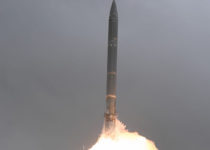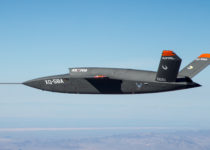AI Could Transform Machine Guns Into Potent Drone Killers
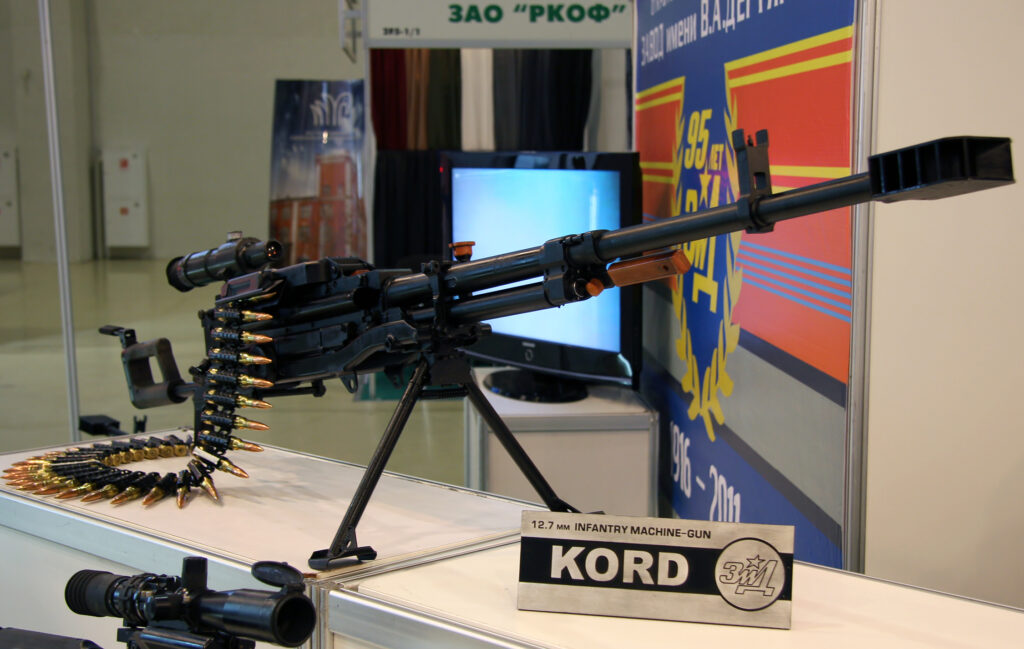
The recent conflict between Armenia and Azarbijan has demonstrated what experts around the world had been warning for a long time- that drones, especially the cheap, suicide drones, that are also called loitoring munitions, are going to be devestating for armored formations, air defense sites, and other instillations of the future battle field. It has even led to speculations that armored formations will soon be rendered obsolete by these suicide drones, just like the battleships were rendered obsolete by aircraft and antiship missiles.
One of the star performers of the Nagorno Karabak conflict was the Israeli Harop drone, operated by the Azarbijani forces. The internet is now awash with footages of this drone slamming into all kinds of Armenian ground targets. The two videos below show these drones in action. The first video, which shows the CCTV footage of a Harop crashing into an Armenian S-300 system, can only play on YouTube because of age restriction. The second video shows footages of multiple Harops as they crash into myrid Armenian platforms and instillations.
AI Algorithms Can Massively Improve The Effectiveness Of Machine Guns
Scenes like these make it clear that drones are going to change the battlefield for ever, and platforms that can’t adopt to this new fact will quickly be rendered obsolete. History shows, however, ample examples of counter technologies evolving to meet the challanges of new technologies. And in the case of suicide drones like Harop, they just might meet their match in a combination of artificial intelligence and the good old machine guns and autocannons.
One example of AI enhancing the capabilities of guns to the point that they can be used in anti drone roles is the Israeli Smash 2000 system. It was originally developed to hit ground moving targets like enemy soldiers. It works by combining simple firearms with an AI driven image processing software. How it works is that once the user locks on to a target and pulls the trigger, the algorithm calculates the movement of the target, predicts its next position, and fires the bullet only when the target is precisely in its cross hairs.
This system makes targetting moving targets at long ranges so easy that it essentially transforms any soldier with even an assault rifle, into a sniper, without needing either specialized training or a dedicated sniper rifle. But the thing that also makes this a potent antidrone system is that there isn’t much difference between a moving ground target like an enemy soldier, and a moving aireal target ike a quadcopter. All that is required to effectively use it in anti drone role is a little tweaking of the AI algorithm. And indeed, with these tweaks, it is already being offered as an anti drone system.
AI And The 12.7 mm Machine Gun
Systems like Smash 2000 may currently be focused on assault rifles. But if AI algorithms can transform assult rifles into antidrone weapons, there is no reason why they can’t enhance the anti drone capabilities of larger caliber machine guns, like the 12.1 mm machine gunes, or even the 38 or 40 mm autocannons used primarily in the anti aircraft role. Afterall, the ballistics are the same, as are the type of targets. All that differs is caliber and scale. The small assault rifles could be potent against small drones like quadcopters if used with AI algorithms. But to take out larger, loitoring munitions like the Harop, larger caliber guns are needed.
Technically speaking, the large auto cannons like the 40 mm Bofors (also called the L70), or the 38 mm ZSU-23, could also really benefit from AI algorithms in anti drone role, making them capable of taking out large suicide drones like the Harop, and we will come to them later in this post. But the 12.7 mm guns like the Kord, the NSV, or even the good old M2 Brownings and DShKs of World War 2 vintage would also be invaluable in antidrone operations.
While the larger guns like 40 mm L70 or 28 mm ZSU-23 are more powerful, they are too heavy and expensive to be installed on many vehicles that are vulnerable to drones, like tanks, APCs, tracked/wheeled artillery guns, and supply trucks. There are dedicated air defence vehicles equipped with these guns. The Shilka for example, carries four ZSU-23 guns. These air defence vehicles could escort other vehicles. But they are few and far between compared to the sheer number of tanks, APCs, and other vehicles that need to be protected from drones.
The 12.7 mm machine guns on the other hand, are light enough to be carried by every individual tank, APC and even truck. This means that if these guns are enabled by AI to effectively target suicide drones, they could make all these vehicles somewhat self suffecient in defending themselves from suicide drones, instead of always needing to be escorted by air defence vehicles like the Shilka.
And the 12.7 mm machine guns, despite their relitavely small size, are excellent short range air defence systems capable of taking down even crewed aircraft and helicopters. In fact, ground and aircraft mounted 12.7 mm guns were one of the primary antiaircraft weapons used in World War 2. They were the guns mouted on the wings or nose World War 2 era fighter planes, and in the gunner pods of World War 2 era bombers, and they performed well in this role. They can therefore, easily take down a Harop sized suicide drone, especially if the drone is coming towards them, to crash into the very vehicle they are mounted on, like a tank.
The only thing that makes these drones hard to target with 12.7 mm machine guns is the difficulty in detecting them due to their small size and low RCS (Radar Cross Section). And this is where AI could help. Visually detecting loitering munitions, both through EO (Electro Optical), IR (Infrared) sensors, and acoustic sensors, is easier for an AI algorithm than by a human. Reconnissance and armed drones like HALE and MALE UAVs typically fly at a high altitude, making it hard to see or hear them from ground. But a suicide drone would have to streak towards the target to crash into it, making it easy to both see and hear by an algorithm after it comes close enough.
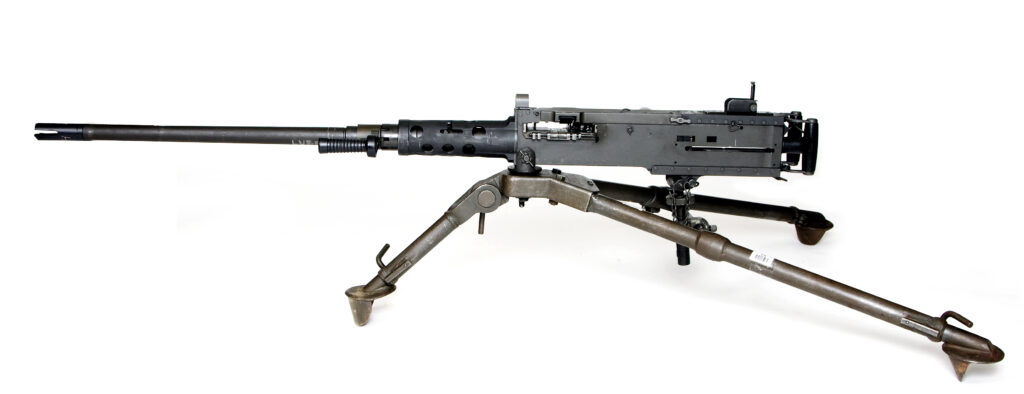
Larger Calibre Machine Guns With AI Would Have Their Own Anti Drone Roles
Let’s now come to larger machine guns like the 40 mm L 70. These guns, as said before, are too heavy and expensive to be mounted on tanks, trucks and other vehicles for self protection, which limits their utility. They do, however, have an advantage over the 12.7 mm guns. Unlike the 12.7 mm guns, which usually fire bullets, these guns can fire shells containing pellets. When these shells come close to an aerial target, they explode, spraying the area around them with deadly pallets that can puncture through the aircraft, destroying it.
This means that these guns don’t have to aim as accurately as the 12.7 mm guns. Because the large area covered by these pellets means that the shell just needs to explode in proximity of the target instead of directly hitting it. The 12.7 mm guns, on the other hand, need to directly hit the target with bullets to take it down. When these larger machine guns are coupled with AI algorithms, making it easier for them to detect and target drones, and also network together to take on drone swarms, they would be very potent drone killers.
In fact, the L70 gun used by the Indian army is being enabled for use in anti drone role. In this case, the publically available information suggests that the system will first estimate the location of the drone by detecting its RF (Radio Frequency) emissions. Atlease at present, most drones invariably emit these emissions to communicate with their human controllers, although this might become less and less frequent as AI makes drones more and more autonomous.
The system then feeds this information about the RF emissions of the drone to the gun’s optical or IR sensors, which turn themselves in the direction of the RF emissions to detect the drone, and use video zooming to estimate the distance of the gun from the drone. Following this, the gun lets out a four round burst, saturating that region in the sky with pallets to take down the drone. Theoratically, the detection of RF emissions could also be used in combination with acoustic sensors to more effeciently estimate the position of the drone.
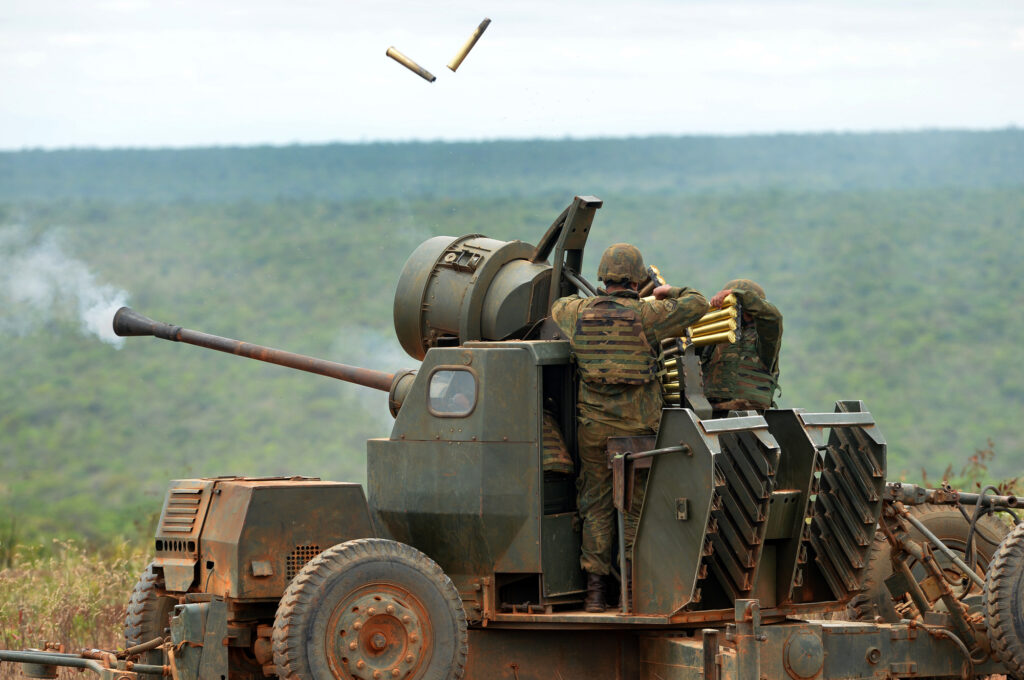
Automation By AI And Networking Could Make Machine Guns Even More Potent
Using AI enabled targetting systems on manually operated machine guns can significantly improve the ability to use the gun in anti drone role. But the limitations of human abilities still constrain the system from realizing its full capabilities. However, these 12 mm machine guns can even be remotely operated now, as the video below shows. These remote control mechanisms are currently manually operated by the human gunner inside the vehicle. Their primary objective is to allow the gunner to stay in the relative safety of the vehicle instead of having to get on the vehicle’s roof to operate the machine gun.
However, it’s concievable that these remote control systems could be operated not by a human gunner, but by AI algorithms, taking away all the human limitations from the operation of the gun and allowing the gun to operate at its very best in antidrone role. This would make it a truly unmanned anti drone system. And unmanned capability might become vital to target unmanned aerial systems, which themselves aren’t constrained by limitations of human pilots, like the limits on the amount of G forces they can pull, or the longer time that humans take to make decisions compared to AI.
Another leap in capabilities of these systems can come from them being networked together. Networking could help the machine guns mounted on different vehicles coordinate their operations, designating a different aerial target to each gun based on the gun’s proximity and visibility of the target. This can be helpful in dealing with a swarm drone attack, and is similar to how cruise missile and drone swarms designate targets to be attacked by each missile or drone, so that the same target isn’t attacked by multiple missiles or drones. Theoratically, the human gunnerc could also coordinate their operations. But the time AI takes to make these decisions is absolutely dwarfed by the time taken by a group of humans.
Conclusion
Application of AI on a combination of machine guns in different ways could create effective kinetic anti drone systems in future. Imagine an armored formation consisting of tanks and APCs, followed by supply trucks, penetrating enemy territory (you can read more about how such formations operate in this previous post by me). This formation would be vulnerable to enemy suicide drones, which might not be effectively taken down either by the friendly combat aircraft providing air cover to the formation, or by the missile based air defense vehicles accompanying the formation.
Even if the missile based air defence vehicles manage to detect and take down the drones, using limited and expensive missiles against cheap and abundant drones is economically unsustainable and would leave less missiles to defend against enemy strike aircraft, against which they would really be needed. This issue could be addressed by 40 mm gun based air defence vehicles accompanying the formation (like the Swedish CV90 pictured below), and the other vehicles in the formation, including tanks, APCs and trucks, carrying 12.7 mm machine gus. Both the 40 mm and 12.7 mm guns would use AI to detect and target drones autonomously, with minimal human intervention.
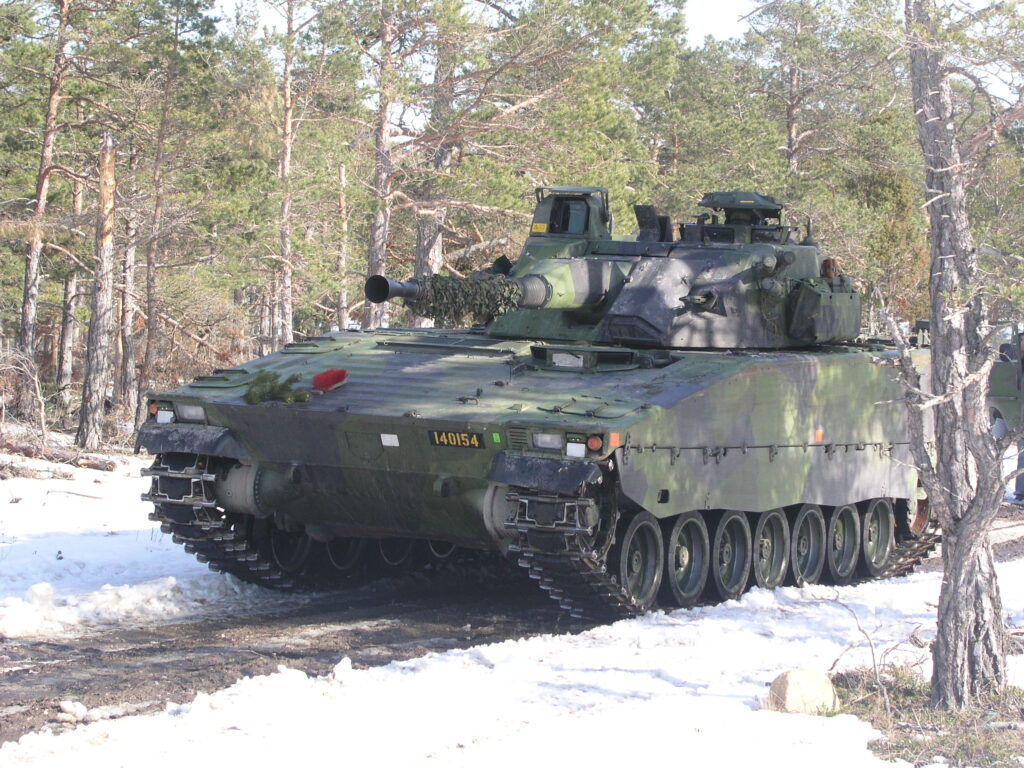
Finally, networking between these guns and AI helping them divide targets between them and coordinate their attacks would make them even more potent against swarm drone attacks. AI would help the guns decide where and when to use the guns of which calibre. The 40 mm guns for example, could saturate the regions with a high density of incomming suicide drones with pallets, and the 12.7 mm guns on individual vehicles could attempt to take down the suicide drones that escape the 40 mm gun barrage and are diving at the vehicles.
Moreover, suicide drones may try to dive on the target vartically if the gun mounted on the target can not shoot at 90 degrees. In such cases too, networking and AI could enable the entire group of guns to think together, and shoot that drone using an adjacent gun instead of the gun mounted on the vehicle the drone is going to crash into. The role of AI in such networked warfare is something I will cover in more detail in a future post soon.

